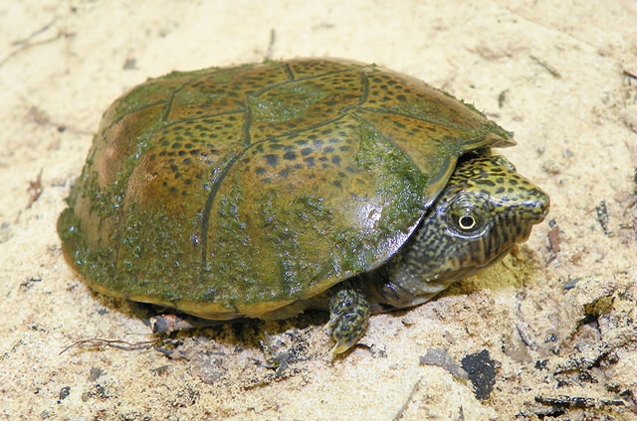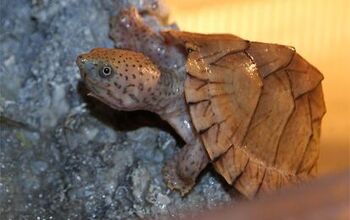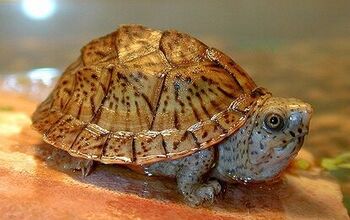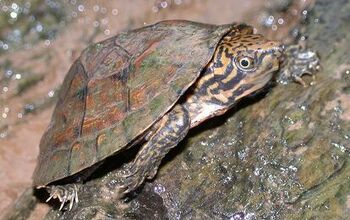Flattened Musk Turtle


About Flattened Musk Turtle
The Flattened Musk Turtle is one of five species of Musk Turtles that include the Razorback Musk Turtle, Loggerhead Musk Turtle, Stripe-Necked Musk Turtle, and Common Musk Turtle. As is the case with all other Musk Turtles, this animal will release a foul smelling liquid when frightened, so care needs to be taken to ensure your pet will feel safe and at ease.
This breed is rare in the pet trade, so it might be difficult to find one. However, like all other turtle breeds, it is best to purchase your Flattened Musk Turtle from a reputable breeder who can ensure that your pet was born and raised in captivity, especially since these turtles are already endangered. Taking turtles out of their wild habitats could lead to a decline in their populations, and animals that are captive bred tend to be healthier and more accustomed to the presence of humans.
The Flattened Musk Turtle is one of five species of Musk Turtles.
Flattened Musk Turtles are found in Alabama, particularly in the upper Black Warrior River system. This species can survive in a range of lakes and streams, but it prefers small rivers and free-flowing creeks that have vegetation and rocks.
What distinguishes the Flattened Musk Turtle from the other Musk Turtle breeds is the fact that it does not feature a keel on the carapace. Instead, the top is flattened and the carapace is serrated slightly on the back edge.
Two barbels are seen on this turtle’s chin, and all four of the feet are webbed. Males will have spine-tipped tails that are thick and long.
The upper shell of the Flattened Musk Turtle will range from a dark brown hue to a yellowish brown or orange color.
The upper shell of the Flattened Musk Turtle will range from a dark brown hue to a yellowish brown or orange color. It will also feature small black streaks and spots.
The plastron will be yellowish to pink, while the head and the body of these turtles will be mottled with black and will be olive green in color. Often you will find spots on the top of this turtle’s snout, as well as narrow stripes on the sides and top of the neck.
It is recommended that you have, at a minimum, a 40-gallon aquarium for an adult Flattened Musk Turtle. However, to give your pet enough room to swim, it is best to get an aquarium that is longer rather than tall. While a hatchling will only require water that is up to 4” deep, adults will need a minimum of 8-12” when it comes to water depth. Also, because these turtles need their water to be clean at all times, a high quality filtration system will be necessary.
Don’t put too much décor in your tank, although a couple of hiding places will keep your turtle happy. Just make sure that he can’t get caught and drown. Build up one end of the tank with driftwood, rocks, and other materials that will lead to a basking area. Although your pet will spend the majority of time underwater and will not bask often, there should always be one in place. Over the basking area, set up a heat lamp to heat the spot to around 90°F, and also set up a UV light over the enclosure.
A water temperature of 72-78°F can be maintained with the help of a water heater, and ambient air temperature can be maintained in the mid-80s Fahrenheit with the use of a heater over the enclosure.
Artificial or live plants can be added to the tank to create a natural looking habitat and even more hiding places. If you are using live plants, make sure that they are non-toxic, as your turtle may decide to eat them. And for substrate, you can choose to add large gravel, silt, or sand to the bottom of the tank, or you can keep the bottom of the tank empty.
Flattened Musk Turtles are shy animals that should only be kept as pets by those who will be fine with simply observing them.
In the wild, Flattened Musk Turtles will primarily consume aquatic insects and mollusks. Adults, in particular, will feed on aquatic snails, as well as mussels and clams, but juveniles will usually feast on aquatic insects instead.
In addition to non-toxic aquatic plants, snails, and insects, you can also provide your Flattened Musk Turtle with a commercial pelleted diet to fulfill all of your pet’s nutritional needs. You can feed an adult every two or three days, but juveniles will need to eat every day or at least every other day.
Flattened Musk Turtles are shy animals that should only be kept as pets by those who will be fine with simply observing them. This is not a good choice if you are hoping to bring home a turtle that you will be able to handle a lot. In fact, you should keep handling of these turtles to a minimum and only do so when it is necessary. When handled, they may be inclined to bite if they are stressed or scared.
Photo credit: Barry R/Flickr; Bill Hughes/Flickr

Lisa Selvaggio is a freelance writer and editor, and our resident cats-pert, with certifications in pet nutrition and pet first aid. She enjoys producing content that helps people understand animals better so they can give their pets a safe and happy home.
More by Lisa Selvaggio
























